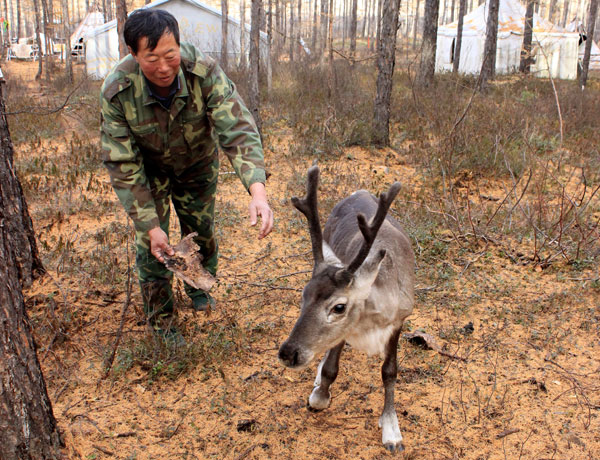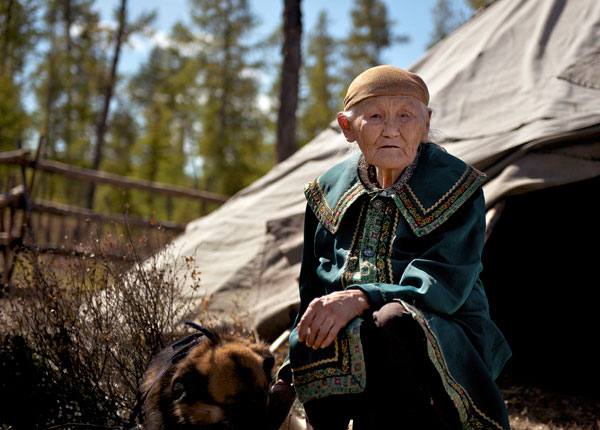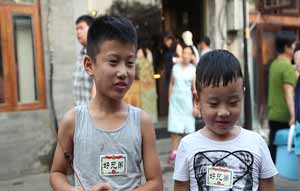Last of the reindeer hunters
Updated: 2013-10-15 07:35
(China Daily)
|
||||||||
 |
|
Xiao Liangzhu tends to one of his reindeer at his hunting lodge near Aoluguya township in the Inner Mongolia autonomous region. Wang Kaihao / China Daily |
Ewenki herders stick to old way of life as their border forest regions undergo dramatic changes, report Wang Kaihao and Yang Fang in Genhe, Inner Mongolia
Editor's note: This is the ninth in a regular series of reports brought together under the banner "Lost Horizons", which aim to show life in the less-reported areas of the country and to give a voice to those whose words often go unheard. Slideshows and video footage are also available at www.chinadaily.com.cn/video
It was late September and the breathtaking scenery dyed in boundless golden color spread across the Greater Hinggan Mountains in the far northeastern district of Hulunbuir in the Inner Mongolia autonomous region.
As one approaches Genhe, one of China's most northerly county-level administrative districts, a road sign reads "Latitude 50 N". This is the site of China's record low -52.6 C.
Forests cover more than 91 percent of the land in Genhe. Paths through the birch forest were like soft blankets, paved with fallen leaves and withered grass. It was 3:30 pm, and Xiao Liangzhu, a member of the Ewenki ethnic group, had already started preparing dinner in front of a tent.
"The electricity is off because the generator is broken," said Xiao, 58. "I need to hurry before sunset. Once it gets dark, it's time to go to bed."
There are no cellphone signals or any TV channels, let alone an Internet connection. However, life is never boring for Xiao and his wife, because of their beloved reindeers.
 |
|
Maria Suo is the matriarch of the Aoluguya. She has lived in the area for more than 90 years. Provided to China Daily |
Xiao and his brother raise 82 reindeer in this hunting station, one of eight in the area around Genhe. In 1980, the brothers moved from the south of the Greater Hinggan Mountains to the north to join the Aoluguya, an Ewenki tribe that migrated from the far side of the Ergun River, which forms the border between China and Russia, in the late 17th century to escape military conflict.
Compared with 2.5 million reindeer raised by the world's 20 or so ethnic groups in nine countries near the Arctic Circle, the Aoluguya's current 1,200 animals seem a small fragment, but it is the only tribe that still practices reindeer husbandry in China. The animal was the major mode of transport for the locals right up until the 1950s.
"I became a hunter when I was a teenager. I cannot imagine life without the forests or reindeer," said an emotional Xiao. "Every year, I spend one to two months staying with the new-born reindeer from April onward and that close contact means they will stay close to humans later in life.
"Nevertheless, reindeer can never really be tamed. They wander in the forest at night, looking for moss to eat, but they always remember to come back. They go out at night and return around 6 am during the summer."
Xiao moves his tents several times a year to minimize the environmental impact of the animals and the presence of humans.
"Moss needs time to grow. The Ewenki people have always known how to get along with the forest," he said. "We have never caused even a single forest fire here in the many centuries we've lived here."
"This forest is a paradise of precious animal species such as the flying dragon, also known as the hazel grouse, and elk. The environment has remained unchanged all these years, but our lives haven't," he said.

 Storm swamps car insurance firms
Storm swamps car insurance firms
 Smartphone firm rockets into the US
Smartphone firm rockets into the US
 3 US economists share 2013 Nobel Prize in Economics
3 US economists share 2013 Nobel Prize in Economics
 Canton Fair to promote yuan use
Canton Fair to promote yuan use
 Vintage cars gather in downtown Beijing
Vintage cars gather in downtown Beijing
 Riding the wave of big bargain buy-ups
Riding the wave of big bargain buy-ups
 Senate leads hunt for shutdown and debt deal
Senate leads hunt for shutdown and debt deal
 Chinese education for Thai students
Chinese education for Thai students
Most Viewed
Editor's Picks

|

|

|

|

|

|
Today's Top News
All 86 tourists evacuated from Mount Qomolangma
Obama hopeful as meeting nears with lawmakers
Canton Fair to promote yuan use
Over 380 detained in Moscow riot
86 trapped at Mount Qomolangma camp amid snow
Going green can make good money sense
Window cracks for progress in Iran
Senate leader 'confident' fiscal crisis can be averted
US Weekly

|

|







